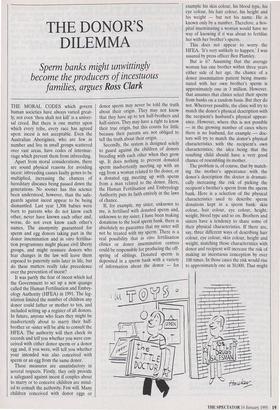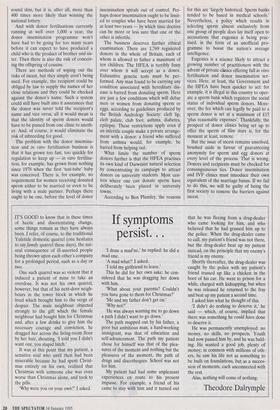THE DONOR'S DILEMMA
Sperm banks might unwittingly become the producers of incestuous
families, argues Ross Clark
THE MORAL CODES which govern human societies have always varied great- ly; not even 'thou shalt not kill' is a univer- sal creed. But there is one matter upon which every tribe, every race has agreed upon: incest is not acceptable. Even the Australian Aborigines, who are few in number and live in small groups scattered over vast areas, have codes of intermar- riage which prevent them from inbreeding.
Apart from moral considerations, there are sound physical reasons for avoiding incest: inbreeding causes faulty genes to be multiplied, increasing the chances of hereditary diseases being passed down the generations. No sooner has this science been understood, however, than the safe- guards against incest appear to be being dismantled. Last year 1,306 babies were born to parents who do not know each other, never have known each other and, worse, do not even know each other's names. The anonymity guaranteed for sperm and egg donors taking part in the donor insemination and in vitro fertilisa- tion programmes might please civil liberty groups, and might reassure donors who fear changes in the law will leave them exposed to paternity suits later in life, but do these matters really take precedence over the prevention of incest?
It was partly the fear of incest which led the Government to set up a new quango called the Human Fertilisation and Embry- ology Authority (HFEA) in 1991. The leg- islation limited the number of children any donor could father or mother to ten, and included setting up a register of all donors. In future, anyone who fears they might be inadvertently about to marry their half- brother or -sister will be able to consult the HFEA. The authority will then check its records and tell you whether you were con- ceived with either donor sperm or a donor egg and, if you were, will tell you whether your intended was also conceived with sperm or an egg from the same donor.
These measures are unsatisfactory in several respects. Firstly, they only provide a safeguard against incest if couples about to marry or to conceive children are mind- ed to consult the authority. Few will. Many children conceived with donor eggs or donor sperm may never be told the truth about their origin. They may not know that they have up to ten half-brothers and half-sisters. They may have a right to know their true origin, but this counts for little because their parents are not obliged to tell the truth about their origin.
Secondly, the system is designed solely to guard against the children of donors breeding with each other when they grow up. It does nothing to prevent donated sperm inadvertently meeting up with an egg from a woman related to the donor, or a donated egg meeting up with sperm from a man related to the donor. Here, the Human Fertilisation and Embryology Authority puts its faith entirely in the laws of chance.
If, for example, my sister, unknown to me, is fertilised with donated sperm and, unknown to my sister, I have been making donations to the local sperm bank, there is absolutely no guarantee that my sister will not be treated with my sperm. There is a real possibility that in vitro fertilisation clinics or donor insemination centres could be responsible for producing the off- spring of siblings. Donated sperm is deposited in a sperm bank with a variety of information about the donor — for
example his skin colour, his blood type, his eye colour, his hair colour, his height and his weight — but not his name. He is known only by a number. Therefore, a hos- pital inseminating a woman would have no way of knowing if it was about to fertilise her with her brother's sperm.
This does not appear to worry the HFEA. 'It's very unlikely to happen,' I was assured by press officer Ben Plumley.
But is it? Assuming that the average woman has one brother within three years either side of her age, the chance of a donor insemination patient being insemi- nated with her own brother's sperm is approximately one in 3 million. However, that assumes that clinics select their sperm from banks on a random basis. But they do not. Wherever possible, the clinic will try to match the donor's physical description with the recipient's husband's physical appear- ance. However, where this is not possible — in the growing number of cases where there is no husband, for example — doc- tors will try to match the donor's physical characteristics with the recipient's own characteristics; the idea being that the resulting child should have a very good chance of resembling its mother.
The problem is, of course, that by match- ing the mother's appearance with the donor's description the doctor is dramati- cally increasing the risk of picking the recipient's brother's sperm from the sperm bank. Here is a selection of the physical characteristics used to describe sperm donations kept in a sperm bank: skin colour, hair colour, eye colour, height, weight, blood type and so on. Brothers and sisters have a tendency to share some of their physical characteristics. If there are, say, three different ways of describing hair colour, eye colour, skin colour, height and weight, matching those characteristics with donor and recipient will increase the risk of making an incestuous conception by over 100 times. In those cases the risk would rise to approximately one in 30,000. That might sound slim, but it is, after all, more than 400 times more likely than winning the national lottery.
And with donor fertilisations currently running at well over 1,000 a year, the donor insemination programme won't have had to be going for too many years before it can expect to have produced a child who is the product of brother and sis- ter. Then there is also the risk of conceiv- ing the offspring of cousins.
There are methods of wiping out the risks of incest, but they simply aren't being used. For example, the recipient could be obliged by law to supply the names of her close relations and they could be checked against the donor's name. Such a system could still have built into it assurances that the donor was never told the recipient's name and vice versa; all it would mean is that the identity of sperm donors would have to be passed from one clinic to anoth- er. And, of course, it would eliminate the risk of inbreeding for good.
The problem with the donor insemina- tion and in vitro fertilisation business is that it has grown too fast, too quickly for regulation to keep up — in vitro fertilisa- tion, for example, has grown from nothing since 1978 when the first 'test-tube' baby was conceived. There is, for example, no requirement for women receiving donated sperm either to be married or even to be living with a male partner. Perhaps there ought to be one, before the level of donor
insemination spirals out of control. Per- haps donor insemination ought to be limit- ed to couples who have been married for at least two years — by which time doctors can be more or less sure that one or the other is infertile.
The business deserves further ethical examination. There are 1,769 registered donors in the whole of Britain, each of whom is allowed to father a maximum of ten children. The HFEA is terribly fussy over whom it will accept as a donor. Exhaustive genetic tests must be per- formed. Any man found to be carrying any condition associated with hereditary dis- ease is barred from donating sperm. Here are just a few conditions which will debar men or women from donating sperm or eggs, according to guidelines produced by the British Andralogy Society: cleft lip, cleft palate, club foot, asthma, diabetes, epilepsy. These restrictions apply even if an infertile couple make a private arrange- ment with a donor: a friend who suffered from asthma would, for example, be barred from helping out.
What limits the number of sperm donors further is that the HFEA practises its own kind of Darwinist natural selection by concentrating its campaign to attract donors on university students. Most cen- tres where one can donate sperm have deliberately been placed in university towns.
According to Ben Plumley, the reasons for this are 'largely historical. Sperm banks tended to be based in medical schools.' Nevertheless, a policy which results in selecting sperm almost exclusively from one group of people does lay itself open to accusations that eugenics is being prac- tised, in the form of an unofficial pro- gramme to boost the nation's average intelligence.
Eugenics is a science likely to attract a growing number of practitioners with the advent of private clinics offering full in vitro fertilisation and donor insemination ser- vices. Here, at least, the Government and the HFEA have been quicker to act: for example, it is illegal in this country to oper- ate a sperm bank which registers the social status of individual sperm donors. More- over, the fee which can legally be paid to a sperm donor is set at a maximum of £15 `plus reasonable expenses'. Thankfully, the prospect of donor clinics being set up to offer the sperm of film stars is, for the moment at least, remote.
But the issue of incest remains unsolved, brushed aside in favour of guaranteeing anonymity for sperm and egg donors at every level of the process. That is wrong. Donors and recipients must be checked for consanguineous ties. Donor insemination and IVF clinics must introduce their own equivalent of the marriage banns. If we fail to do this, we will be guilty of being the first society to remove the barriers against incest.










































 Previous page
Previous page